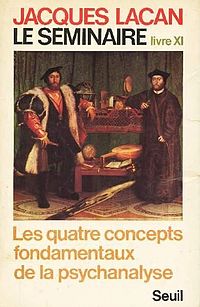Related Research Articles
Feminist film theory is a theoretical film criticism derived from feminist politics and feminist theory influenced by Second Wave Feminism and brought about around the 1970s in the United States. With the advancements in film throughout the years feminist film theory has developed and changed to analyse the current ways of film and also go back to analyse films past. Feminists have many approaches to cinema analysis, regarding the film elements analyzed and their theoretical underpinnings.
Film theory is a set of scholarly approaches within the academic discipline of film or cinema studies that began in the 1920s by questioning the formal essential attributes of motion pictures; and that now provides conceptual frameworks for understanding film's relationship to reality, the other arts, individual viewers, and society at large. Film theory is not to be confused with general film criticism, or film history, though these three disciplines interrelate.

Jacques Marie Émile Lacan was a French psychoanalyst and psychiatrist. Described as "the most controversial psycho-analyst since Freud", Lacan gave yearly seminars in Paris from 1953 to 1981, and published papers that were later collected in the book Écrits. His work made a significant impact on continental philosophy and cultural theory in areas such as post-structuralism, critical theory, feminist theory and film theory, as well as on the practice of psychoanalysis itself.
Gender studies is an interdisciplinary academic field devoted to analysing gender identity and gendered representation. Gender studies originated in the field of women's studies, concerning women, feminism, gender, and politics. The field now overlaps with queer studies and men's studies. Its rise to prominence, especially in Western universities after 1990, coincided with the rise of deconstruction.

Laura Mulvey is a British feminist film theorist. She was educated at St Hilda's College, Oxford. She is currently professor of film and media studies at Birkbeck, University of London. She previously taught at Bulmershe College, the London College of Printing, the University of East Anglia, and the British Film Institute.
In psychology and psychiatry, scopophilia or scoptophilia is an aesthetic pleasure drawn from looking at an object or a person. In human sexuality, the term scoptophilia describes the sexual pleasure that a person derives from looking at prurient objects of eroticism, such as pornography, the nude body, and fetishes, as a substitute for actual participation in a sexual relationship.
Screen theory is a Marxist–psychoanalytic film theory associated with the British journal Screen in the early 1970s. It considers filmic images as signifiers that do not only encode meanings but also mirrors in which viewers accede to subjectivity. The theory attempts to discover a way of theorizing a politics of freedom through cinema that focuses on diversity instead of unity. Here, the Marxist emphasis on universal consciousness as a basis for defining emancipation shifted to the articulation of diversities and multiplicities of individual and collective experience due to the psychoanalytic elaboration of the unconscious.
Identification refers to the automatic, subconscious psychological process in which an individual becomes like or closely associates themselves with another person by adopting one or more of the others' perceived personality traits, physical attributes, or some other aspect of their identity. The concept of identification was founded by psychoanalyst Sigmund Freud in the 1920’s, and has since been expanded on and applied in psychology, social studies, media studies, and literary and film criticism. In literature, identification most often refers to the audience identifying with a fictional character, however it can also be employed as a narrative device whereby one character identifies with another character within the text itself.

The Four Fundamental Concepts of Psychoanalysis is the 1978 English-language translation of a seminar held by Jacques Lacan. The original was published in Paris by Le Seuil in 1973. The Seminar was held at the École Normale Supérieure in Paris between January and June 1964 and is the eleventh in the series of The Seminar of Jacques Lacan. The text was published by Jacques-Alain Miller.

Bracha Lichtenberg Ettinger is an Israeli artist, painter and writer, visual analyst, psychoanalyst and philosopher, living and working in Paris and Tel Aviv. She is regarded as a major French feminist theorist and prominent international artist in contemporary New European Painting, that invented the concept matrixial (matricial) space / espace matrixiel (matriciel). Ettinger is a professor at European Graduate School in Saas-Fee, Switzerland and at GCAS, Dublin.

In critical theory, sociology, and psychoanalysis, the gaze, in the philosophical and figurative sense, is an individual's awareness and perception of other individuals, other groups, or oneself. The concept and the social applications of the gaze have been defined and explained by existentialist and phenomenologist philosophers. Jean-Paul Sartre described the gaze in Being and Nothingness (1943). Michel Foucault, in Discipline and Punish: The Birth of the Prison (1975), developed the concept of the gaze to illustrate the dynamics of socio-political power relations and the social dynamics of society's mechanisms of discipline. Jacques Derrida, in The Animal That Therefore I Am (1997), elaborated upon the inter-species relations that exist among human beings and other animals, which are established by way of the gaze.
Feminist ethics is an approach to ethics that builds on the belief that traditionally ethical theorizing has undervalued and/or underappreciated women's moral experience, which is largely male-dominated, and it therefore chooses to reimagine ethics through a holistic feminist approach to transform it.
The Matrixial Gaze is a 1995 book by artist, psychoanalyst, clinical psychologist, writer and painter Bracha L. Ettinger. It is a work of feminist film theory that examines the gaze as described by Jacques Lacan, criticises it, and offers an original theory concerning feminine and female gaze. Beginning in 1985, Ettinger's artistic practice and her theoretical invention of a matrixial space articulated around her proposal of a feminine-maternal sphere of encounter that begins in the most archaic (pre-maternal-prenatal) humanised encounter-event, led her to publish a long series of academic articles starting 1992, articulating and developing for some decades what she has called the matrixial theory of trans-subjectivity. The matrixial theory formulates Aesthetics and artistic creativity in terms of withnessing, compassion, wondering and 'fascinance', as well as Ethics of witnessing, responsibility, respect, compassion and care, and the passage from co-reponse-ability to responsibility and from com-passion to compassion. Bracha L. Ettinger invented a field of concepts that have influenced debates in contemporary art, psychoanalysis, women's studies, film studies, feminism, gender studies and cultural studies.
Lacanianism or Lacanian psychoanalysis is a theoretical system that explains the mind, behaviour, and culture through a structuralist and post-structuralist extension of classical psychoanalysis, initiated by the work of Jacques Lacan from the 1950s to the 1980s. Lacanian perspectives contend that the world of language, the Symbolic, structures the human mind, and stress the importance of desire, which is conceived of as endless and impossible to satisfy. Contemporary Lacanianism is characterised by a broad range of thought and extensive debate between Lacanians.
Feminist art criticism emerged in the 1970s from the wider feminist movement as the critical examination of both visual representations of women in art and art produced by women. It continues to be a major field of art criticism.

In feminist theory, the male gaze is the act of depicting women and the world in the visual arts and in literature from a masculine, heterosexual perspective that presents and represents women as sexual objects for the pleasure of the heterosexual male viewer. In the visual and aesthetic presentations of narrative cinema, the male gaze has three perspectives: (i) that of the man behind the camera, (ii) that of the male characters within the film's cinematic representations; and (iii) that of the spectator gazing at the image.
Archaic mother is the mother of earliest infancy, whose continuing influence is traced in psychoanalysis, and whose (repressed) presence is considered to underlie the horror film.
The female gaze is a feminist theory term referring to the gaze of the female spectator, character or director of an artistic work, but more than the gender it is an issue of representing women as subjects having agency. As such all genders can create films with a female gaze. It is a response to feminist film theorist Laura Mulvey's term "the male gaze", which represents not only the gaze of a heterosexual male viewer but also the gaze of the male character and the male creator of the film. In that sense it is close, though different, from the Matrixial gaze coined in 1985 by Bracha L. Ettinger. In contemporary usage, the female gaze has been used to refer to the perspective a female filmmaker (screenwriter/director/producer) brings to a film that might be different from a male view of the subject.
Jean-Louis Baudry was a French novelist, Tel Quel literary editor, and psychoanalytic film theorist.

Todd McGowan is an American Professor of English at the University of Vermont. His work brings together Hegel, psychoanalysis, and existentialism, and the intersection of these lines of thought with the cinema. Todd also hosts a popular podcast, with the co-host Ryan Engley, called Why Theory dedicated to examining cultural phenomena through the lens of continental philosophy and psychoanalytic theory.